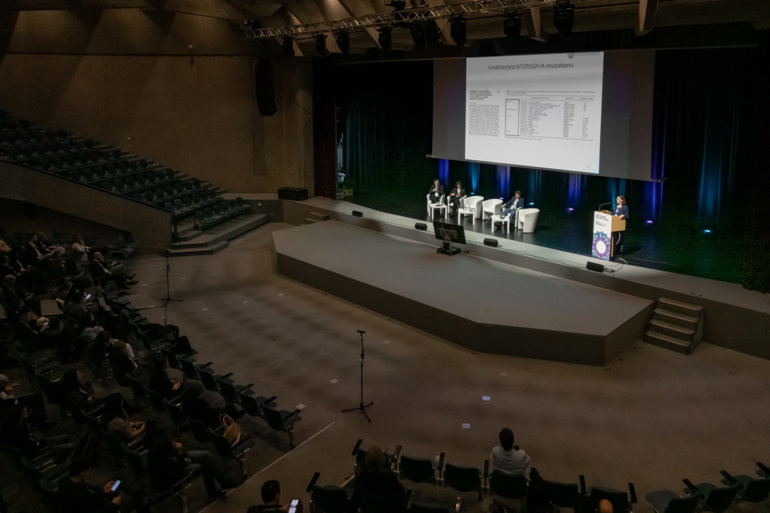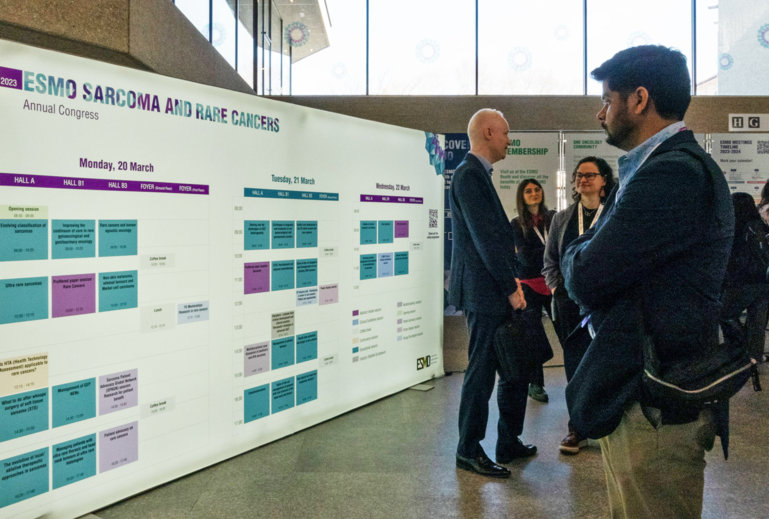While early-phase findings confirm the efficacy and mild toxicity of radiopharmaceuticals, patient selection and logistical issues limit their integration into broad clinical practice
The field of peptide receptor radionuclide therapy (PRRT) for advanced neuroendocrine tumours (NETs) is rapidly evolving, with ongoing trials confirming the activity of current treatments and the clinical benefits of novel, high-energy alpha emitters in both PRRT-exposed and -naïve populations.
Somatostatin receptors are an ideal cellular target for radiopharmaceutical therapy, being highly overexpressed in, and specific to, NETs. Radiation emitted by the isotope induces apoptosis of tumour cells expressing somatostatin receptors and at the same time induces apoptosis of adjacent tumour cells without target receptors, via a bystander effect. The combination of targeted radiopharmaceutical with non-targeted irradiation can be therapeutically beneficial and is a property that conventional targeted agents lack.
PRRT typically shows encouraging efficacy and a very mild toxicity profile, and this is apparent in some findings presented at the ESMO Congress 2025 (Berlin, 17–21 October). For instance, data from a confirmatory phase III study in 196 patients with non-midgut, somatostatin receptor-positive gastroenteropancreatic NETs (GEP-NETs) showed superior progression-free survival (PFS; the primary endpoint) of a median 24.8 months with XTR-008, a [177Lu]Lu-DOTATATE-based PRRT, compared with 5.8 months with high-dose octreotide long-acting repeatable (LAR; hazard ratio 0.14) at approximately 30 months of follow-up (LBA63). In the same study, the respective objective response rates were 55.6% and 2.1%. By comparison, the median PFS at 20 months had not been reached, while the objective response rate was 18% with 177Lu-DOTATATE treatment in the NETTER-1 trial. 177Lu-DOTATATE is a U.S. Food and Drug Administration-approved somatostatin receptor-targeted radiopharmaceutical that demonstrated superior efficacy and a favourable safety profile compared with high-dose octreotide LAR in the benchmark phase III NETTER-1 trial of patients with advanced midgut GEP-NETs (N Engl J Med. 2017;376:125–135).
Further new data with beta-emitting 177Lu-labelled somatostatin analogues have confirmed that they prolonged median progression-free survival (mPFS) compared with everolimus, a standard of care for targeted therapy, in 309 patients with inoperable, progressive, grade 1 or 2 GEP-NETs (Abstract 1706O). Benefits were observed in the phase III COMPETE trial across subgroups stratified by primary tumour origin (gastroentero NETs and pancreatic NETs), tumour grade (grade 1 and grade 2) and prior medical therapy (treatment naïve and 1 prior line), as well as a more favourable safety profile of PRRT (177Lu-edotreotide) than everolimus with premature discontinuations due to adverse events occurring in 1.8% of the 177Lu-edotreotide arm compared with 15.2% of the everolimus arm (p<0.0001).
Data from the COMPETE trial are of importance from a reimbursement perspective in countries where PRRT is currently not approved for use prior to everolimus in this setting.
Effective treatment options are limited for patients with GEP-NETs whose disease progresses after PRRT with beta-emitting 177Lu-labelled somatostatin analogues. However, promising data are emerging from early-phase studies with radiopharmaceuticals containing the alpha-emitting isotope 212Pb.
Alpha emitters are known to have a shorter path length and higher linear energy transfer than beta-emitters, so the likelihood of achieving DNA double-strand breaks is much higher than with beta particles (Front Med. 2022;9:1020188). Tumour reduction rates of up to 60% have been observed in phase I/II studies with 212Pb radiopharmaceuticals, comparing favourably with the 18% and 43% ORR observed with 177Lu-DOTATATE in the NETTER-1 and NETTER-2 trials (N Engl J Med 2017;376:125–135; Lancet. 2024;403:2807–2817). Notably, high antitumour activity has been demonstrated in PRRT (177Lu)-pre-treated (Abstract 1032O) as well as PRRT-naïve patients, and durable responses and high survival rates (88% at 36 months), have been reported in patients with advanced somatostatin receptor-positive GEP-NETs after longer-term follow-up (Abstract 1034MO). Alpha-emitting radiopharmaceuticals appear to have a good safety profile (grade 1 or 2 manageable adverse events are typically reported), with no new safety signals observed at longer follow-up. Phase III data are eagerly awaited.
Despite these compelling early-phase data, the introduction of alpha-emitting radiopharmaceuticals into clinical practice will be challenging in terms of establishing their place in the treatment paradigm among traditional, guideline-recommended PRRT such as 177Lu-DOTATATE. Optimal sequences of traditional and novel radiopharmaceuticals are still to be determined, and new patient selection criteria may be needed to guide personalised treatment options. For example, patients with bulky disease do not respond well to conventional PRRT and alpha-emitting particles with higher linear energy transfer may be more beneficial for this patient subgroup (Cancers (Basel). 2023;15:2975).
Given that the half-lives of the alpha- and beta-emitting therapies differ considerably – 212Pb is ~10 hours and 177Lu-DOTATATE is ~7 days – the treatments also differ in terms of logistical requirements. 177Lu-DOTATATE can be produced in a central location and distributed to centres within a relatively wide area, while 212Pb radiopharmaceutical therapies require local production facilities close to the hospitals where they are to be administered. Nevertheless, alpha-emitting therapies are likely to have a reduced social and emotional burden for patients as their use is governed by less stringent radiation safety legislation than beta-emitting treatments. For example, unlike 177Lu-DOTATATE, 212Pb therapies can be administered in an outpatient setting without the need to isolate from family members.
Looking to the future, there are many clinical and logistical factors to be considered in the selection of optimal radiopharmaceutical therapy for NETs, but a wider choice of treatments will be advantageous for all patients.
Programme details:
Xu J, et al. XT-XTR008-3-01: a phase III study of 177Lu-DOTATATE versus high-dose octreotide long-acting repeatable (LAR) in patients with advanced grade 1–2, well-differentiated, gastroenteropancreatic neuroendocrine tumours (GEP-NETs). ESMO Congress 2025 - LBA63
Capdevila J, et al. Efficacy, safety and subgroup analysis of 177Lu-edotreotide vs everolimus in patients with Grade 1 or Grade 2 GEP-NETs: Phase 3 COMPETE trial. ESMO Congress 2025 - Abstract 1706O
Strosberg JR, et al. Efficacy and safety of targeted alpha therapy 212Pb-DOTAMTATE in patients with unresectable or metastatic gastroenteropancreatic neuroendocrine tumors (GEP-NETs) previously treated with peptide receptor radionuclide therapy (PRRT): Results of a phase 2 study. ESMO Congress 2025 - Abstract 1032O
Chauhan A, et al. Multi-center NCI-sponsored phase 1 study of triapine in combination with 177Lu-DOTATATE in patients with well-differentiated gastroenteropancreatic neuroendocrine tumours (GEP-NETs). ESMO Congress 2025 - Abstract 1709MO
Halfdanarson TR, et al. [212Pb]VMT--NET targeted alpha-particle therapy (TAT) for advanced somatostatin receptor 2 positive (SSTR2+) neuroendocrine tumours (NETs): mature safety and preliminary efficacy for enrollment from dose-finding cohorts 1 and 2 (n=44). ESMO Congress 2025 - Abstract 1033MO
Strosberg JR, et al. Long-term follow-up of peptide receptor radionuclide therapy (PRRT)-naïve patients with gastroenteropancreatic neuroendocrine tumors (GEP-NETs) treated with targeted alpha therapy 212Pb-DOTAMTATE in the phase 2 ALPHAMEDIX 02 trial. ESMO Congress 2025 - Abstract 1034MO







